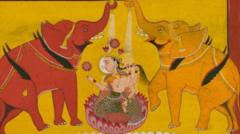

India's spiritual art is a captivating tapestry woven from diverse threads of history, philosophy, and cultural expression. It's a journey that transforms the mundane into the divine, reflecting a profound connection between the earthly and the transcendent. From ancient cave paintings to contemporary masterpieces, the evolution of this art form mirrors the ever-flowing stream of Indian spirituality.
The story begins in the mists of prehistory, with rudimentary rock carvings and paintings in caves and shelters. These early expressions, often depicting animals and hunting scenes, hint at a primal reverence for nature and the interconnectedness of life. As civilizations evolved, so did artistic endeavors, with the Indus Valley Civilization leaving behind intricately carved seals and figurines that suggest a sophisticated understanding of symbolism and religious belief.
The emergence of Hinduism, Buddhism, and Jainism profoundly influenced the course of Indian art. The Mauryan period witnessed the rise of monumental structures like the Sanchi Stupa, adorned with intricate carvings depicting scenes from the Buddha's life. The Gupta period, often considered the golden age of Indian art, saw the flourishing of classical sculpture and painting, characterized by grace, elegance, and a deep sense of spiritual serenity. Deities from the Hindu pantheon were depicted with nuanced expressions and symbolic gestures, conveying complex philosophical concepts in visual form.
The medieval period brought further diversification, with regional styles and artistic traditions flourishing under various dynasties. Temple architecture reached its zenith, with magnificent structures like the Khajuraho temples and the Brihadeeswarar Temple showcasing intricate carvings and sculptures that narrate mythological tales and celebrate the divine. Miniature painting also emerged as a significant art form, with schools like the Mughal, Rajput, and Deccan painting styles developing their unique aesthetics and thematic focus. These paintings often depicted scenes from epics like the Ramayana and Mahabharata, as well as portraits of rulers and courtly life, infused with a sense of spiritual grandeur.
The arrival of Islam in India led to a fusion of artistic styles, with Indo-Islamic art characterized by intricate geometric patterns, calligraphy, and the use of vibrant colors. The Mughal emperors were great patrons of art, and their court artists created masterpieces that blended Persian, Central Asian, and Indian artistic traditions. The Taj Mahal, a symbol of eternal love, stands as a testament to the architectural brilliance and artistic synthesis of this era.
In recent times, a symposium at the Baháʼí House of Worship in New Delhi, highlighted how artistic expression, guided by spiritual principles, can contribute to social transformation. It emphasized art's role in promoting human nobility and social progress, viewing it as more than just entertainment or self-expression. Contemporary Indian artists continue to draw inspiration from their rich spiritual heritage, reinterpreting ancient themes and symbols in innovative ways. From abstract paintings that explore the depths of consciousness to sculptures that celebrate the human form as a vessel of the divine, Indian art remains a vibrant and evolving expression of the country's spiritual quest. Exhibitions like the 'Bhagwat' miniature paintings exhibition, which was recently inaugurated at the Allahabad Museum, serve as powerful reminders of India's cultural unity and artistic heritage, blending religious traditions and artistic expressions.
The journey of India's spiritual art, from serpents to saints, is a testament to the enduring power of human creativity to express the inexpressible and to connect with the divine. It is a journey that continues to unfold, with each new generation of artists adding their unique voice to the symphony of Indian spirituality.